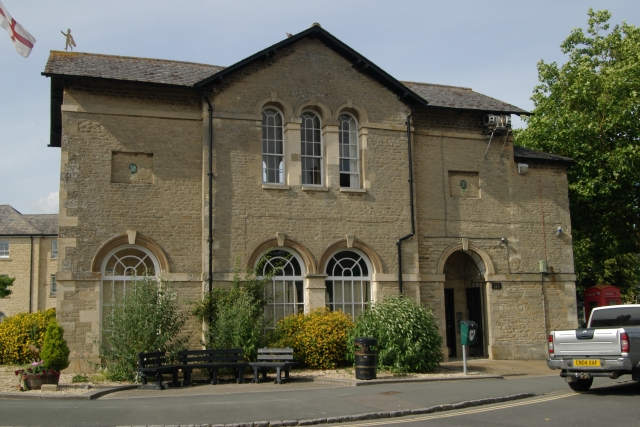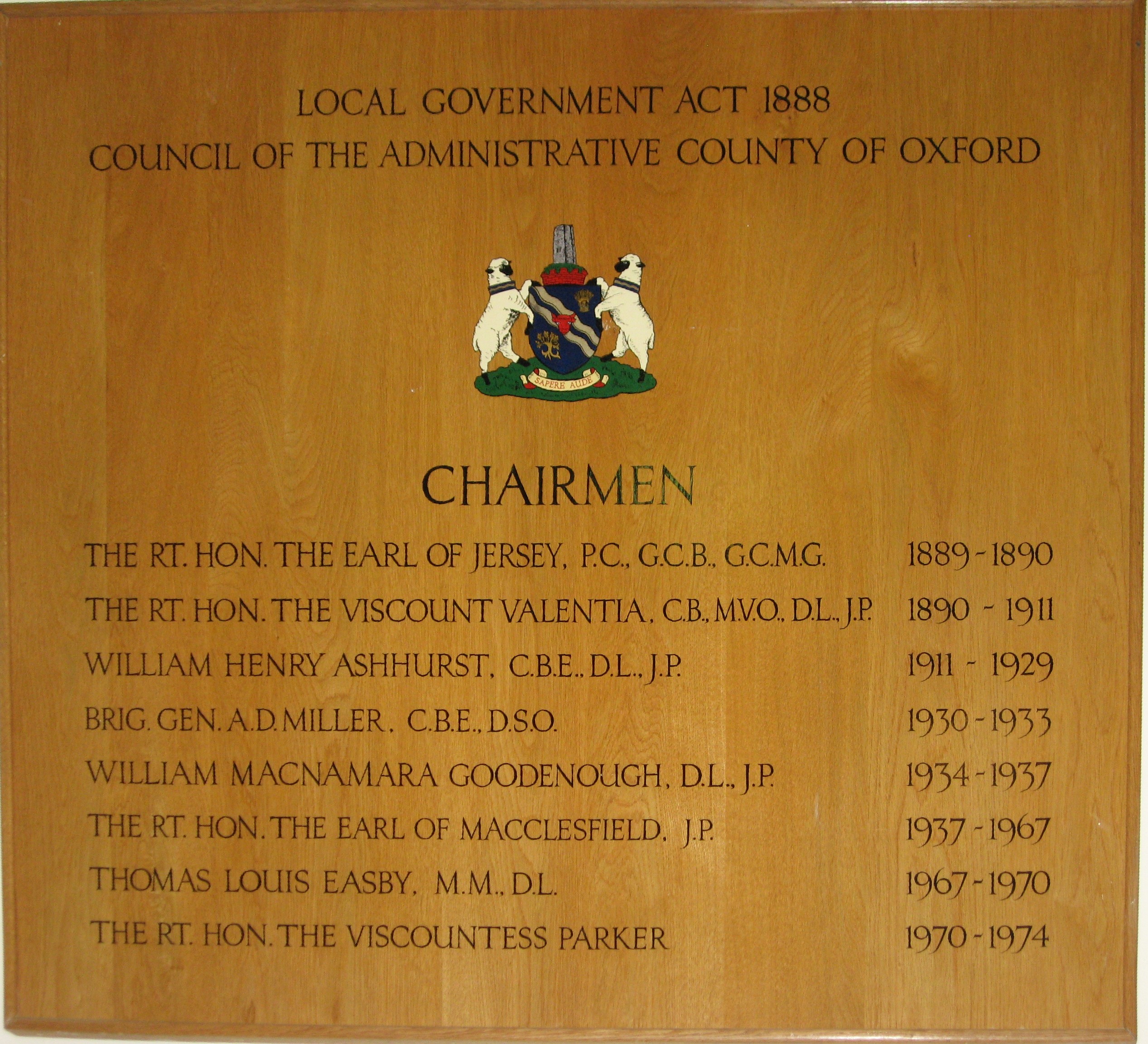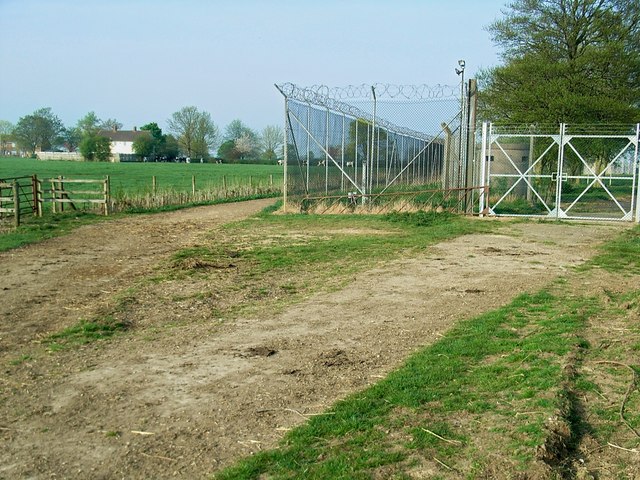|
Bampton Castle, Oxfordshire
Bampton Castle was in the village of Bampton, Oxfordshire (). Differing accounts of its origin exist. One states that in about 1142 AD during the reign of Stephen, Matilda built a motte castle. According to other sources the castle was built in 1314–15, during the reign of Edward II, by Aymer de Valence, Earl of Pembroke, who obtained a licence from the king to "make a castle of his house at Bampton." The castle is mentioned in Skelton's, Antiquities of Oxfordshire, where he states that the castle was four-sided, with a tower at each corner and a fortified gatehouse on the eastern and western sides and corbelled out turrets for additional fortification. The last known account of the castle intact is from Woods manuscript, preserved at Ashmolean Museum, wherein he states that when he visited the castle on the September 7, 1664, nearly the entire western side was intact. The castle was demolished before 1789 but parts of its structure have been incorporated into a house, H ... [...More Info...] [...Related Items...] OR: [Wikipedia] [Google] [Baidu] |
Bampton, Oxfordshire
Bampton, also called Bampton-in-the-Bush, is a settlement and civil parish in the Thames Valley about southwest of Witney in Oxfordshire. The parish includes the hamlet of Weald. The 2011 Census recorded the parish's population as 2,564. Bampton is variously referred to as both a town and a village. The Domesday Book recorded that it was a market town by 1086. It continued as such until the 1890s. It has both a town hall and a village hall. Geography The core of the village is on gravel terraces formed of Summertown-Radley or flood plain terrace deposits. It is just east of Shill Brook, which flows south to join the River Thames, and just north of a smaller stream that flows west to join Shill Brook. The A4095 road passes through the village. The civil parish measures about north – south and about east – west. It is bounded to the south by the River Thames, to the east by Aston Ditch, and to the west and north by ditches and field boundaries. A small part of the airfi ... [...More Info...] [...Related Items...] OR: [Wikipedia] [Google] [Baidu] |
Oxfordshire
Oxfordshire is a ceremonial and non-metropolitan county in the north west of South East England. It is a mainly rural county, with its largest settlement being the city of Oxford. The county is a centre of research and development, primarily due to the work of the University of Oxford and several notable science parks. These include the Harwell Science and Innovation Campus and Milton Park, both situated around the towns of Didcot and Abingdon-on-Thames. It is a landlocked county, bordered by six counties: Berkshire to the south, Buckinghamshire to the east, Wiltshire to the south west, Gloucestershire to the west, Warwickshire to the north west, and Northamptonshire to the north east. Oxfordshire is locally governed by Oxfordshire County Council, together with local councils of its five non-metropolitan districts: City of Oxford, Cherwell, South Oxfordshire, Vale of White Horse, and West Oxfordshire. Present-day Oxfordshire spanning the area south of the Thames was h ... [...More Info...] [...Related Items...] OR: [Wikipedia] [Google] [Baidu] |
Oxfordshire County Council
Oxfordshire County Council is the county council (upper-tier local authority) for the non-metropolitan county of Oxfordshire in the South East of England. It is an elected body responsible for some local government services in the county, including education (schools, libraries and youth services), social services, public health, highway maintenance, waste disposal, emergency planning, consumer protection and town and country planning for matters to do with minerals, waste, highways and education. It is one of the largest employers in Oxfordshire and has a gross expenditure budget of £856.2 million for the 2021–22 financial year. History County councils were first introduced in England and Wales with full powers from 22 September 1889 as a result of the Local Government Act 1888, taking over administrative functions until then carried out by the unelected quarter sessions. The areas they covered were termed administrative counties and were not in all cases identical to the tr ... [...More Info...] [...Related Items...] OR: [Wikipedia] [Google] [Baidu] |
Stephen Of England
Stephen (1092 or 1096 – 25 October 1154), often referred to as Stephen of Blois, was King of England from 22 December 1135 to his death in 1154. He was Count of Boulogne '' jure uxoris'' from 1125 until 1147 and Duke of Normandy from 1135 until 1144. His reign was marked by the Anarchy, a civil war with his cousin and rival, the Empress Matilda, whose son, Henry II, succeeded Stephen as the first of the Angevin kings of England. Stephen was born in the County of Blois in central France as the fourth son of Stephen-Henry, Count of Blois, and Adela, daughter of William the Conqueror. His father died while Stephen was still young, and he was brought up by his mother. Placed into the court of his uncle Henry I of England, Stephen rose in prominence and was granted extensive lands. He married Matilda of Boulogne, inheriting additional estates in Kent and Boulogne that made the couple one of the wealthiest in England. Stephen narrowly escaped drowning with Henry I's son, William ... [...More Info...] [...Related Items...] OR: [Wikipedia] [Google] [Baidu] |
Empress Matilda
Empress Matilda ( 7 February 110210 September 1167), also known as the Empress Maude, was one of the claimants to the English throne during the civil war known as the Anarchy. The daughter of King Henry I of England, she moved to Germany as a child when she married the future Holy Roman Emperor Henry V. She travelled with her husband to Italy in 1116, was controversially crowned in St Peter's Basilica, and acted as the imperial regent in Italy. Matilda and Henry V had no children, and when he died in 1125, the imperial crown was claimed by his rival Lothair of Supplinburg. Matilda's younger and only full brother, William Adelin, died in the ''White Ship'' disaster of 1120, leaving Matilda's father and realm facing a potential succession crisis. On Emperor Henry V's death, Matilda was recalled to Normandy by her father, who arranged for her to marry Geoffrey of Anjou to form an alliance to protect his southern borders. Henry I had no further legitimate children and nominated ... [...More Info...] [...Related Items...] OR: [Wikipedia] [Google] [Baidu] |
Motte And Bailey
A motte-and-bailey castle is a European fortification with a wooden or stone keep situated on a raised area of ground called a motte, accompanied by a walled courtyard, or Bailey (castle), bailey, surrounded by a protective Rampart (fortification), ditch and palisade. Relatively easy to build with unskilled labour, but still militarily formidable, these castles were built across northern Europe from the 10th century onwards, spreading from Normandy and County of Anjou, Anjou in France, into the Holy Roman Empire in the 11th century. The Normans introduced the design into England and Wales. Motte-and-bailey castles were adopted in Scotland, Ireland, the Low Countries and Denmark in the 12th and 13th centuries. Windsor Castle, in England, is an example of a motte-and-bailey castle. By the end of the 13th century, the design was largely superseded by alternative forms of fortification, but the earthworks remain a prominent feature in many countries. Architecture Structures A mott ... [...More Info...] [...Related Items...] OR: [Wikipedia] [Google] [Baidu] |
Edward II Of England
Edward II (25 April 1284 – 21 September 1327), also called Edward of Caernarfon, was King of England and Lord of Ireland from 1307 until he was deposed in January 1327. The fourth son of Edward I, Edward became the heir apparent to the throne following the death of his elder brother Alphonso. Beginning in 1300, Edward accompanied his father on invasions of Scotland. In 1306, he was knighted in a grand ceremony at Westminster Abbey. Following his father's death, Edward succeeded to the throne in 1307. He married Isabella, the daughter of the powerful King Philip IV of France, in 1308, as part of a long-running effort to resolve tensions between the English and French crowns. Edward had a close and controversial relationship with Piers Gaveston, who had joined his household in 1300. The precise nature of their relationship is uncertain; they may have been friends, lovers, or sworn brothers. Edward's relationship with Gaveston inspired Christopher Marlowe's 15 ... [...More Info...] [...Related Items...] OR: [Wikipedia] [Google] [Baidu] |
Aymer De Valence, 2nd Earl Of Pembroke
Aymer de Valence, 2nd Earl of Pembroke (c. 127523 June 1324) was an Anglo-French nobleman. Though primarily active in England, he also had strong connections with the French royal house. One of the wealthiest and most powerful men of his age, he was a central player in the conflicts between Edward II of England and his nobility, particularly Thomas, 2nd Earl of Lancaster. Pembroke was one of the Lords Ordainers appointed to restrict the power of Edward II and his favourite Piers Gaveston. His position changed with the great insult he suffered when Gaveston, as a prisoner in his custody whom he had sworn to protect, was removed and beheaded at the instigation of Lancaster. This led Pembroke into close and lifelong cooperation with the King. Later in life, however, political circumstances combined with financial difficulties would cause him problems, driving him away from the centre of power. Though earlier historians saw Pembroke as the head of a "middle party", between the ex ... [...More Info...] [...Related Items...] OR: [Wikipedia] [Google] [Baidu] |
Listed Building
In the United Kingdom, a listed building or listed structure is one that has been placed on one of the four statutory lists maintained by Historic England in England, Historic Environment Scotland in Scotland, in Wales, and the Northern Ireland Environment Agency in Northern Ireland. The term has also been used in the Republic of Ireland, where buildings are protected under the Planning and Development Act 2000. The statutory term in Ireland is " protected structure". A listed building may not be demolished, extended, or altered without special permission from the local planning authority, which typically consults the relevant central government agency, particularly for significant alterations to the more notable listed buildings. In England and Wales, a national amenity society must be notified of any work to a listed building which involves any element of demolition. Exemption from secular listed building control is provided for some buildings in current use for worship, ... [...More Info...] [...Related Items...] OR: [Wikipedia] [Google] [Baidu] |
RAF Bampton Castle
Royal Air Force Bampton Castle or RAF Bampton Castle is a former non-flying Royal Air Force station near Bampton Castle, Oxfordshire. The base was established by the Royal Corps of Signals in 1939 and handed over to the RAF in 1969. It was the home of No. 2 and No. 81 Signal Units, which dealt with high frequency radio communications. Day-to-day operations were overseen (parented in RAF speak) by RAF Brize Norton due to the larger base's proximity to Bampton Castle and that Brize was the home of No. 38 Group Tactical Communications Wing (and successors until 2006). The station closed progressively between 2003 and 2006 when the RAF's high frequency communications system was replaced by the Defence High Frequency Communications Service The Defence High Frequency Communications Service or the DHFCS is a British military beyond line-of-sight communication system operated by the Ministry of Defence (MOD) and used predominately by the UK Armed Forces, as well as other authoris ... [...More Info...] [...Related Items...] OR: [Wikipedia] [Google] [Baidu] |
The Chronicles Of Hugh De Singleton
The Chronicles of Hugh de Singleton, Surgeon are a series of fictional medieval mysteries written by Mel Starr. The first, published in 2008 by Monarch Books, is ''The Unquiet Bones''. The second, published in 2009, is ''A Corpse at St. Andrew's Chapel''. The third, published in 2010, is ''A Trail of Ink''. The fourth, published in 2011, is ''Unhallowed Ground''. The fifth, sixth & seventh in the series are ''The Tainted Coin'', ''Rest Not in Peace'' and ''The Abbot's Agreement.'' Subsequent books in the series include ''Ashes to Ashes'', ''Lucifer's Harvest,'' ''Deeds of Darkness'', ''Prince Edward's Warrant'', ''Without a Trace'', ''The Easter Sepulchre'', and ''Master Wycliffe’s Summons''. Plot Hugh de Singleton is a newly practicing surgeon in medieval Oxford, England when he comes to the aid of a local lord who is injured. The Lord hires him to come to his manor of Bampton, and subsequently to be his Bailiff at Bampton Castle (which was an existing castle in the 13 ... [...More Info...] [...Related Items...] OR: [Wikipedia] [Google] [Baidu] |
Telephone Exchange
A telephone exchange, telephone switch, or central office is a telecommunications system used in the public switched telephone network (PSTN) or in large enterprises. It interconnects telephone subscriber lines or virtual circuits of digital systems to establish telephone calls between subscribers. In historical perspective, telecommunication terms have been used with different semantics over time. The term ''telephone exchange'' is often used synonymously with ''central office'', a Bell System term. Often, a ''central office'' is defined as a building used to house the inside plant equipment of potentially several telephone exchanges, each serving a certain geographical area. Such an area has also been referred to as the exchange or exchange area. In North America, a central office location may also be identified as a ''wire center'', designating a facility to which a telephone is connected and obtains dial tone. For business and billing purposes, telecommunication carriers defi ... [...More Info...] [...Related Items...] OR: [Wikipedia] [Google] [Baidu] |








.jpg)